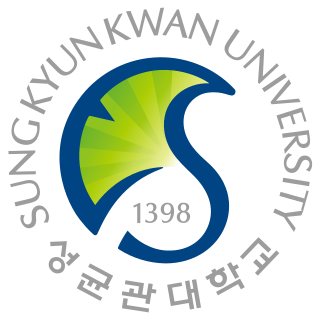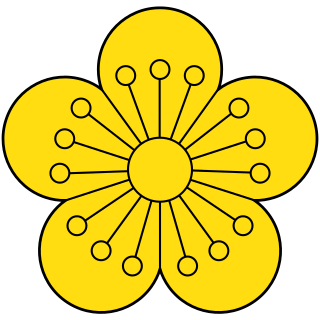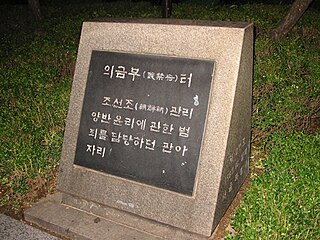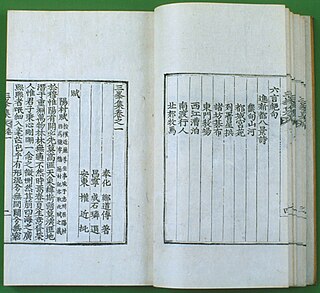
Jeong Do-jeon, also known by his art name Sambong (삼봉), was a prominent Korean scholar-official during the late Goryeo to the early Joseon periods. He served as the first Chief State Councillor of Joseon, from 1392 until 1398 when he was killed by the Joseon king Yi Bang-won. Jeong Dojeon was an adviser to the Joseon founder Yi Seong-gye and also the principal architect of the Joseon dynasty's policies, laying down the kingdom's ideological, institutional, and legal frameworks which would govern it for five centuries.

Sungkyunkwan University is a private research university with campuses in Seoul and Suwon, South Korea.
The Protectorate-General to Pacify the East was an administrative division of the Chinese Tang dynasty in Manchuria and the northern part of the Korean Peninsula. It was established after the Tang dynasty defeated Goguryeo and annexed its territories. In the place of Baekje and Goguryeo, the Tang dynasty created the Protectorate General to Pacify the East and the Ungjin Commandery. A proposal to set up the Great Commandery of Gyerim by the Emperor Gaozong of Tang to King Munmu of Silla was refused.

The Dongguk Tonggam is a chronicle of the early history of Korea compiled by Seo Geo-jeong (서거정) (1420–1488) and other scholars in the 15th century. Originally commissioned by King Sejo in 1446, it was completed under the reign of Seongjong of Joseon, in 1485. The official Choe Bu was one of the scholars who helped compile and edit the work. The earlier works on which it may have been based have not survived. The Dongguk Tonggam is the earliest extant record to list the names of the rulers of Gojoseon after Dangun.

The House of Yi, also called the Yi dynasty, was the royal family of the Joseon dynasty and later the imperial family of the Korean Empire, descended from the Joseon founder Yi Seong-gye. All of his descendants are members of the Jeonju Yi clan.

Samyeongdang (1544–1610), also known by his dharma name Yujeong, was a Korean Buddhist monk during the Joseon era. He is sometimes identified by his art name, Song-un. He was born to a family of the Im clan in Miryang, Gyeongsang Province. After the deaths of his mother in 1558 and his father in 1559, he became a monk at Jikjisa on Hwangaksan in Gimcheon.

Jeotgal (Korean: 젓갈) or jeot (젓), translated as salted seafood, is a category of salted preserved dishes made with seafood such as shrimps, oysters, clams, fish, and roe. Depending on the ingredients, jeotgal can range from flabby, solid pieces to clear, broth-like liquid.

Gwanbok is a Korean term which was borrowed from the Chinese terms guanfu and guanfu. The term gwanbok is a collective term which refers to historical official attire, which was bestowed by the government court, including Chinese courts of various dynasties. The guanfu (冠服) system was a court attire system in China which also formed part of the Hanfu system. This system was them spread to neighbouring countries and was adopted in Korea since ancient times in different periods through the ritual practice of bestowal of clothing. Acknowledgement through bestowed robes and crowns (冠服) from the Emperor of China, who held hegemony over East Asia, would give support to Korean Kings and successors, as being the authentic rulers of their country as well as confirmed the political status of the Korean kingdom in the rest of the Sinosphere. The gwanbok system in Korea was different for each kingdom and changed throughout different periods. For example, initially given by the Chinese court in ritual practice, successive gwanbok were more often than not locally manufactured in Korea with different colours and adopted into hanbok. The gwanbok, which was used as the uniform of court officials, formed part of the gwanbok system and was used like the suit is nowadays.

Yeonguijeong was a title created in 1400, during the Joseon and Korean Empire periods (1392–1910), and given to the Chief State Councillor as the highest government position of "Uijeongbu". Existing for over 500 years, the function was handed over in 1895 during the Gabo Reform to the newly formed position of the Prime Minister of Korea. Only one official at a time was appointed to the position and though was generally called Yeongsang, was also referred to as Sangsang, Sugyu or Wonbo. Although the title of Yeonguijeong was legally defined as the highest post in charge of all state affairs, its practical functions changed drastically depending on the particular King and whether that King's power was strong or weak.
Uinyeo were female physicians who specialized in the treatment of women during the Joseon dynasty of Korea. The uinyeo were established as a solution to social taboos against women receiving treatment from male physicians. The uinyeo system first appeared in 1406 after King Taejong ordered its establishment in the Jesaengwon.
Sanggung was an official title of the senior 5th rank, the highest attainable for gungnyeo, a lady-in-waiting during the Joseon Dynasty of Korea. Female officers with the title were assigned to govern the inner affairs of the palace. When a regular nain served for more than 15 years, she would be awarded with an ornamental hairpin for a sanggung. Therefore, a newly appointed sanggung was usually 35–45 years old. A court lady at the rank of sanggung was treated well enough to live in her own house with servants.
The Seungjeongwon was the Royal Secretariat during the Joseon dynasty of Korea (1392–1910) in charge of receiving and delivering the king's order. The office was also called Jeongwon, Huwon, Eundae, or Daeeonsa. According to the Gyeongguk daejeon, the Seungjeongwon had six royal secretaries, whose ranks were in the 3rd senior grade, as well as two recorders. The duties of the royal secretaries were primarily to deliver the monarch's orders to government organizations and to report on official affairs of the state organizations to the throne. The six secretary system is explained by the fact that the government of Joseon was composed of six boards. The six secretaries served respectively the Boards of Personnel, War, Taxation, Rites, Works, and Punishment. However, the secretaries were not limited to liaison work between the six boards and the monarch; they also reported to the king the business of all government offices, primary among these being the State Council (Uijeong-bu), the Office of Censor-General (Saganwon), and the Office of Inspector-General (Saheon-bu). As the name implies, the primary duty of the recorders was to make a record of all the official business handled by the secretaries. As the work of the secretaries had to be conducted at all hours, and it was required that they have ready access to the monarch at all times, the office of the Seungjeongwon was established within easy reach of the king at court.
Crown Prince Uigyeong, personal name Yi Jang and formerly called as Prince Dowon was a Crown prince of the Korean Joseon Dynasty. He was the oldest son of Sejo of Joseon and Queen Jeonghui, also the older brother of Yejong of Joseon. He was the spouse of Queen Insu and the biological father of Seongjong of Joseon.

Uigeumbu refers to the judiciary organ during Goryeo and Joseon dynasty in Korea. Another names are Geum-o or Wangbu. The structure was in charge of questioning the case of treason or interrogating felons. Uigeumbu takes the equivalent position of today's Supreme Court.

The history of education in Korea can be traced back to the Three Kingdoms of Korea, or even back to the prehistoric period. Both private schools and public schools were prominent. Public education was established as early as the 400 AD. Historically, the education has been heavily influenced by Confucianism and Buddhism.
Hongmungwan, or the Office of Special Advisors, was one of the Three Offices of Joseon; it acted as the Joseon dynasty's administrative and research agency.
Podocheong, literally Agency for Thieves Arresting, was a government body that was responsible for the arrest and punishment of criminals during the Joseon Dynasty of Korea. It was a temporary organization at first, but was solidified into a permanent one later in the Dynasty. Podocheong was divided into a left sector and a right sector, each assigned to the corresponding administrative district of Hanseongbu and Gyeonggi Province. Its role was remarkably analogous to the modern police.
Uuijeong, also the Right State Councilor, was the Third State Councillor of the Uijeongbu during the Joseon Dynasty of Korea. The Uuijeong was variously referred to as Usang, Ujeongseung, Ugyu, Uhap, or Udae.
Crown Princess Gonghoe of the Musong Yun clan, sometimes referred to as Yun Gonghoe-bin, was a Joseon crown princess as the wife of Crown Prince Sunhoe, the only son of King Myeongjong and Queen Insun.

Sambongjip (삼봉집) is a collection of works by Jeong Do-jeon (정도전), a key figure in the founding of Joseon and in the creation of Joseon's philosophy of government. It is a compilation of Jeong Do-jeon (Sambong)'s poetry, prose, philosophy, and his plans for the reformation of the Goryeo /Joseon) government.











